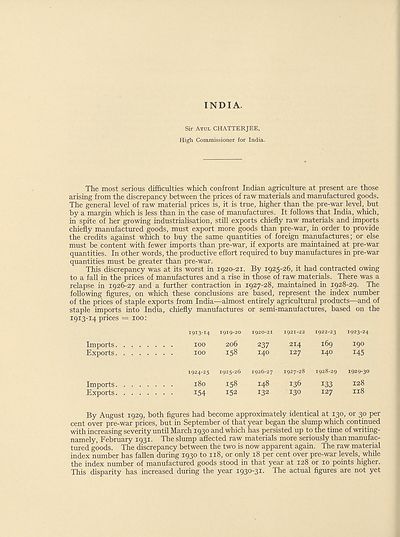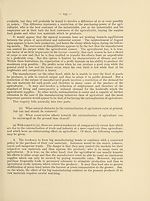Download files
Complete book:
Individual page:
Thumbnail gallery: Grid view | List view

INDIA.
Sir Atul CHATTERJEE,
High Commissioner for India.
The most serious difficulties which confront Indian agriculture at present are those
arising from the discrepancy between the prices of raw materials and manufactured goods.
The general level of raw material prices is, it is true, higher than the pre-war level, but
by a margin which is less than in the case of manufactures. It follows that India, which,
in spite of her growing industrialisation, still exports chiefly raw materials and imports
chiefly manufactured goods, must export more goods than pre-war, in order to provide
the credits against which to buy the same quantities of foreign manufactures; or else
must be content with fewer imports than pre-war, if exports are maintained at pre-war
quantities. In other words, the productive effort required to buy manufactures in pre-war
quantities must be greater than pre-war.
This discrepancy was at its worst in 1920-21. By 1925-26, it had contracted owing
to a fall in the prices of manufactures and a rise in those of raw materials. There was a
relapse in 1926-27 and a further contraction in 1927-28, maintained in 1928-29. The
following figures, on which these conclusions are based, represent the index number
of the prices of staple exports from India—almost entirely agricultural products—and of
staple imports into India, chiefly manufactures or semi-manufactures, based on the
1913-14 prices — 100:
1913-14 1919-20 1920-21 1921-22 1922-23
Imports.
Exports.
100
100
206
158
237
140
214
127
169
140
1923-24
190
145
Imports.
Exports.
1924-25 1925-26
180 158
154
152
1926-27 1927-28 1928-29 1929-30
148 136 133 128
132 130 127 118
By August 1929, both figures had become approximately identical at 130, or 30 per
cent over pre-war prices, but in September of that year began the slump which continued
with increasing severity until March 1930 and which has persisted up to the time of writing-
namely, February 1931. The slump affected raw materials more seriously than manufac¬
tured goods. The discrepancy between the two is now apparent again. The raw material
index number has fallen during 1930 to 118, or only 18 per cent over pre-war levels, while
the index number of manufactured goods stood in that year at 128 or 10 points higher.
This disparity has increased during the year 1930-31. The actual figures are not yet
Sir Atul CHATTERJEE,
High Commissioner for India.
The most serious difficulties which confront Indian agriculture at present are those
arising from the discrepancy between the prices of raw materials and manufactured goods.
The general level of raw material prices is, it is true, higher than the pre-war level, but
by a margin which is less than in the case of manufactures. It follows that India, which,
in spite of her growing industrialisation, still exports chiefly raw materials and imports
chiefly manufactured goods, must export more goods than pre-war, in order to provide
the credits against which to buy the same quantities of foreign manufactures; or else
must be content with fewer imports than pre-war, if exports are maintained at pre-war
quantities. In other words, the productive effort required to buy manufactures in pre-war
quantities must be greater than pre-war.
This discrepancy was at its worst in 1920-21. By 1925-26, it had contracted owing
to a fall in the prices of manufactures and a rise in those of raw materials. There was a
relapse in 1926-27 and a further contraction in 1927-28, maintained in 1928-29. The
following figures, on which these conclusions are based, represent the index number
of the prices of staple exports from India—almost entirely agricultural products—and of
staple imports into India, chiefly manufactures or semi-manufactures, based on the
1913-14 prices — 100:
1913-14 1919-20 1920-21 1921-22 1922-23
Imports.
Exports.
100
100
206
158
237
140
214
127
169
140
1923-24
190
145
Imports.
Exports.
1924-25 1925-26
180 158
154
152
1926-27 1927-28 1928-29 1929-30
148 136 133 128
132 130 127 118
By August 1929, both figures had become approximately identical at 130, or 30 per
cent over pre-war prices, but in September of that year began the slump which continued
with increasing severity until March 1930 and which has persisted up to the time of writing-
namely, February 1931. The slump affected raw materials more seriously than manufac¬
tured goods. The discrepancy between the two is now apparent again. The raw material
index number has fallen during 1930 to 118, or only 18 per cent over pre-war levels, while
the index number of manufactured goods stood in that year at 128 or 10 points higher.
This disparity has increased during the year 1930-31. The actual figures are not yet
Set display mode to:
![]() Universal Viewer |
Universal Viewer | ![]() Mirador |
Large image | Transcription
Mirador |
Large image | Transcription
Images and transcriptions on this page, including medium image downloads, may be used under the Creative Commons Attribution 4.0 International Licence unless otherwise stated. ![]()
| League of Nations > Economic and financial section > Agricultural crisis > Volume 1 > (196) |
|---|
| Permanent URL | https://digital.nls.uk/190905198 |
|---|
| Shelfmark | LN.II.2/2.(35) |
|---|---|
| Attribution and copyright: |
|
| Shelfmark | LN.II.2/2.(35-35) |
|---|---|
| Shelfmark | LN.II |
|---|
| Description | Over 1,200 documents from the non-political organs of the League of Nations that dealt with health, disarmament, economic and financial matters for the duration of the League (1919-1945). Also online are statistical bulletins, essential facts, and an overview of the League by the first Secretary General, Sir Eric Drummond. These items are part of the Official Publications collection at the National Library of Scotland. |
|---|---|
| Additional NLS resources: |
|

